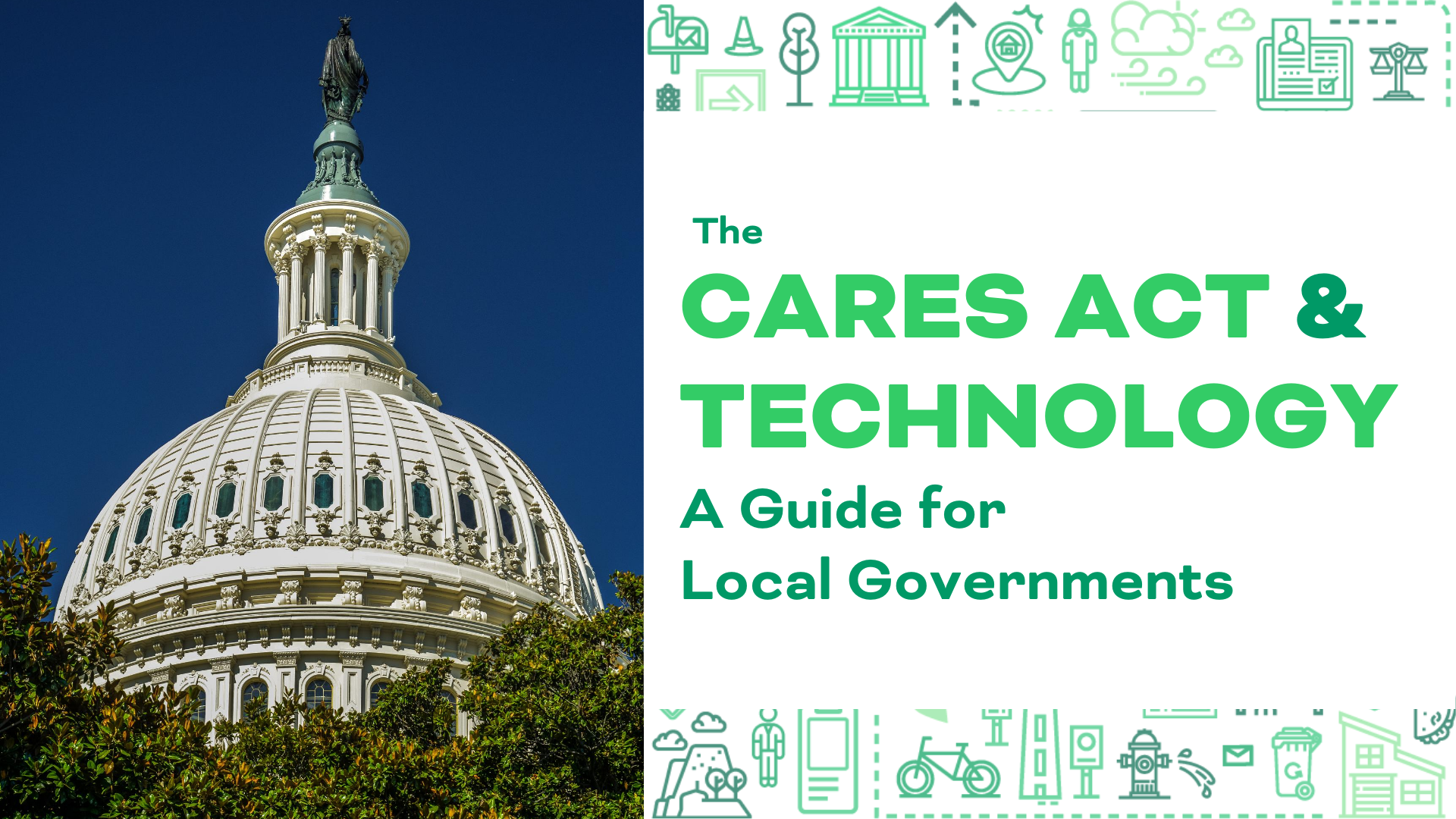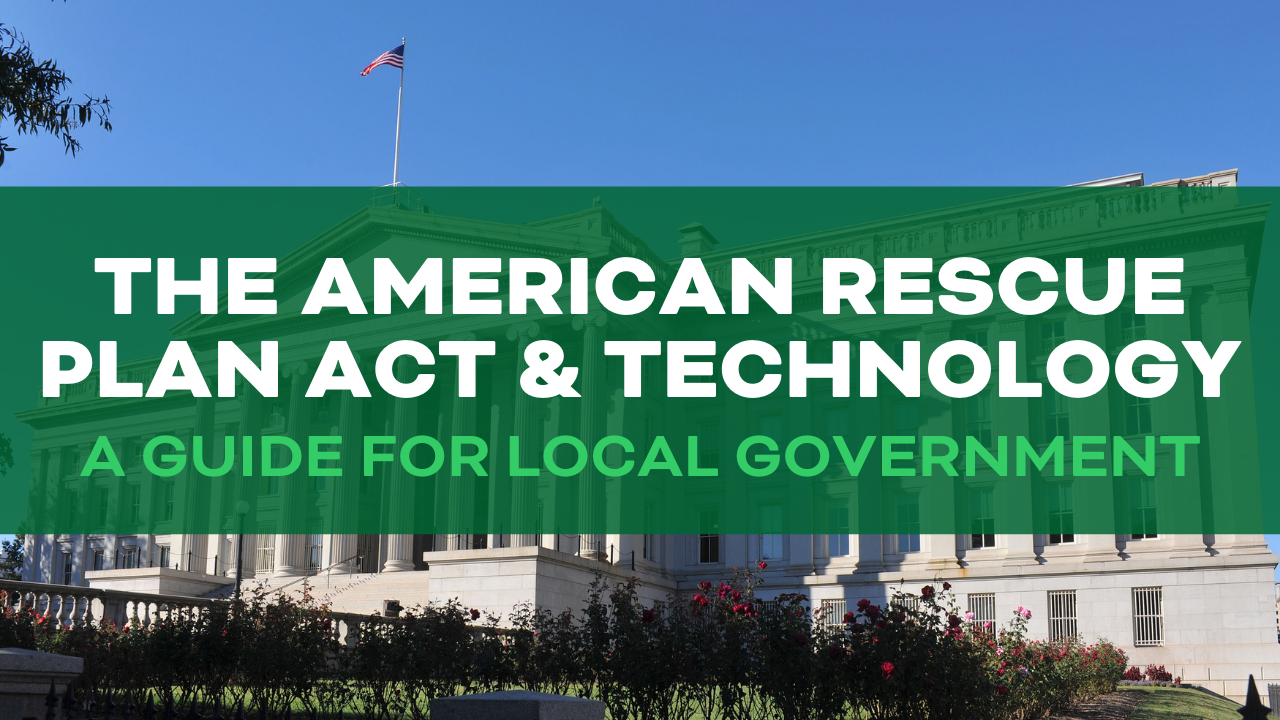THIS Article WAS UPDATED ON June 7, 2021 to include information about the American Rescue Plan Act. Previously, it was updated on December 28, 2020 TO reflect federal policy updates regarding cares act funding.
Local governments have stepped up to help residents during the COVID-19 pandemic. Demands for existing and new public services soared amidst an unexpected transition to Telework. Though times are tough for everyone, City and County governments around the country have improved processes, identified needs in the community, and addressed the moment.
But there’s a lot more to do. As the country continues to feel the effects of this public health crisis, many local governments must determine how to rectify lost revenue. Each local organization and the federal government will have to tackle the looming budgetary threat. For now, the CARES Act provides funds that governments can use for expenses related to COVID-19.
Here’s a breakdown of what local governments need to know about CARES Act. We've compiled information about funding in the Act, how that applies to software investments, and examples of how state and local governments are using CARES to serve citizens with technology.
What is the CARES act?
 The Coronavirus Aid, Relief, and Economic Security (CARES) Act “provides fast and direct economic assistance for American workers and families, small businesses, and preserves jobs for American industries,” according to the US Department of the Treasury. This economic relief package of over $2 trillion was signed into law on March 27th, 2020.
The Coronavirus Aid, Relief, and Economic Security (CARES) Act “provides fast and direct economic assistance for American workers and families, small businesses, and preserves jobs for American industries,” according to the US Department of the Treasury. This economic relief package of over $2 trillion was signed into law on March 27th, 2020.
For state, local, and tribal governments, the CARES Act established $150 billion for Coronavirus relief. There are three primary areas of guidance for eligible government expenses under the CARES Act. Expenses covered:
- are necessary expenditures incurred due to the COVID-19 public health emergency
- were not accounted for in the budget as of March 27, 2020 for the State or government
- were or will be incurred between March 1, 2020, and December 31, 2021
- (NOTE: an extension to expenditures made under the CARES Act was granted on December 27, 2020 with the ratification of H.R. 133. Previously, all CARES Act expenditures were required to be incurred by December 30, 2020.)
Important links for local government
- Full CARES Act Bill via Congress.gov
- Full Consolidated Appropriations Act (H.R. 133) Bill via Congress.gov, including the amended CARES Act funding date in Section 1001.
- CARES Act funding guidelines for state, territorial, local, and tribal governments via the Department of the Treasury
- Coronavirus relief fund FAQs, including responses to questions about transference of funds and specific spending eligibility
Distribution of funds to local governments in the CARES act
$150 billion in CARES act funding for local governments was to be divided among any “…county, municipality, town, township, village, parish, borough, or other unit of general government below the State level with a population that exceeds 500,000.” Here is the list of all eligible counties, cities, and towns.
Once funds are received, local governments can transfer funds to other units of government. For example, a county may transfer the funds it receives to cities, towns, or school districts.
Each unit of government receiving CARES act funding took a different approach to transferring and allocating funds. One common method we saw was funds being sent directly to counties based on their population. From there, the county determined how to divide funding, often based on specific requests from other local governments within its jurisdiction.
Important links for local government
- Maximum allocation of CARES Act funding by state
- COVID-19 Local Action Tracker, via the National League of Cities and Bloomberg Philanthropies
- Example: the State of Washington has made public its allocation of CARES Act funding to local governments
HUD and CARES: additional funding available to local government

On May 11, the U.S. Department of Housing and Urban Development (HUD) announced that it would allocate $1 billion in CARES Act Coronavirus relief funding to state and insular area governments. As part of the Community Development Block Grant (CDBG) program, local governments can use these funds to provide a wide range of public services to prevent, prepare for, or respond to COVID-19.
Important links for local government
- HUD + CARES funding allocation methodology
- HUD guide to CARES Act spending flexibilities for CDBG grantees
Can you purchase software with CARES Act funding?
Experts say yes; you can use CARES act funding for software or technology purchases. You must ensure that your purchase meets the three guidelines provided by the Department of the Treasury, as stated earlier in this article. But if you have identified any new need not already in your budget, it is likely permitted.
For example, if a CRM would help your local government enhance services available to residents and businesses by facilitating online communications, service and information requests, documentation, and payments, that would meet the guidelines.
Ask yourself these questions to determine fit:
- Will this technology help us respond to or serve citizen needs resulting from the Coronavirus pandemic?
- Is this a net-new initiative that was not in our budget prior to March 27th, 2020?
- Will we be able to incur the costs of this technology between March 1st, 2020, and December 31st, 2021?
What software can support Coronavirus Relief?
How can software help your local government navigate the challenges of the COVID-19 pandemic and serve residents in this time of need? Here are a few examples of software investments that may help you serve citizens:
- Create a CRM database of service delivery that can record, deliver, and share information across government agencies
- Digitize and therefore increase access to new or existing citizen-facing services, such as payments, permitting, or housing applications
- Reduce the increased burden upon traditional 311 call centers by digitizing non-emergency services, increasing accessibility for citizens
- Provide a seamless omnichannel experience so residents can reach local government on their preferred communication channel
Collaborative citizen engagement can help your local government get residents the services they need during COVID-19 without creating a massive burden for staff. We’d be happy to show you how.
Local Governments are Buying New Software and Technology During COVID-19
Here are examples of how local governments are seeking and leveraging new technology to solve COVID-19 problems.
- The need to digitize services has become an urgent need for cities like Phoenix, AZ (pop. 1.6 million). According to a recent RFP, “in response to the COVID-19 pandemic, the City of Phoenix has an urgent need to fast-track and enhance online services to residents and businesses. To reduce the need for individuals to physically interact with staff, documents, and facilities, the City wishes to implement a world-class non-emergency 311 customer relationship management (CRM) system to facilitate online communications, service and information requests, documentation, and payments.”
- Clay County, Florida (pop. 219,252) has listed software development and management as a Phase 1 government project for its CARES funding.
- Many cities have moved quickly to digitize services. For example, the library of Corpus Christi, TX (pop. 325,733) announced new digital library capabilities to provide more services remotely.
- Carteret County, NC (pop. 69,473) is using CARES Act funding to support new technology purchases. “We’re primarily going to use our funding for technology needs, and we are putting our money in the category ‘Expenses of actions to facilitate compliance with COVID-19-related public health measures,’” says County Finance Director Dee Menshaw.
- In Albemarle County, VA (pop. 109,330), $950,000 of CARES Act funds will be invested in technology infrastructure. This includes internet access for students as well as some broadband projects.
COVID-19 Funding for Technology: What’s Next?
The second major Coronavirus relief bill, passed into law on December 27, 2020, did not include funding for state or local governments. However, this bill did include an extension for the spending of funds under the original CARES Act allocation. The deadline for expenses incurred was extended by one year, from December 30, 2020 to December 31, 2021. This gives local government extra time to allot funds already granted for COVID-19 relief.
Will there be any additional federal funding made available to local governments for COVID-19 support? On March 11, 2021, the third round of Coronavirus economic impact payments known as the American Rescue Plan Act (ARPA) became law. ARPA includes $130.2 billion in direct payments for local government, with its own funding distribution and regulations for spending.
Learn more about the American Rescue Plan Act and Technology >>
What we do know is that groups like the National League of Cities, the National Association of Counties, and the United States Conference of Mayors are all advocating for additional funding in subsequent phases of relief. These organizations provide a bounty of advocacy resources. We recommend you check out the NLC’s Cities are Essential Resources and the Conference of Mayors’ Fiscal Pain Tracker
We will continue to monitor the situation and provide updates if and when additional policies are implemented.

